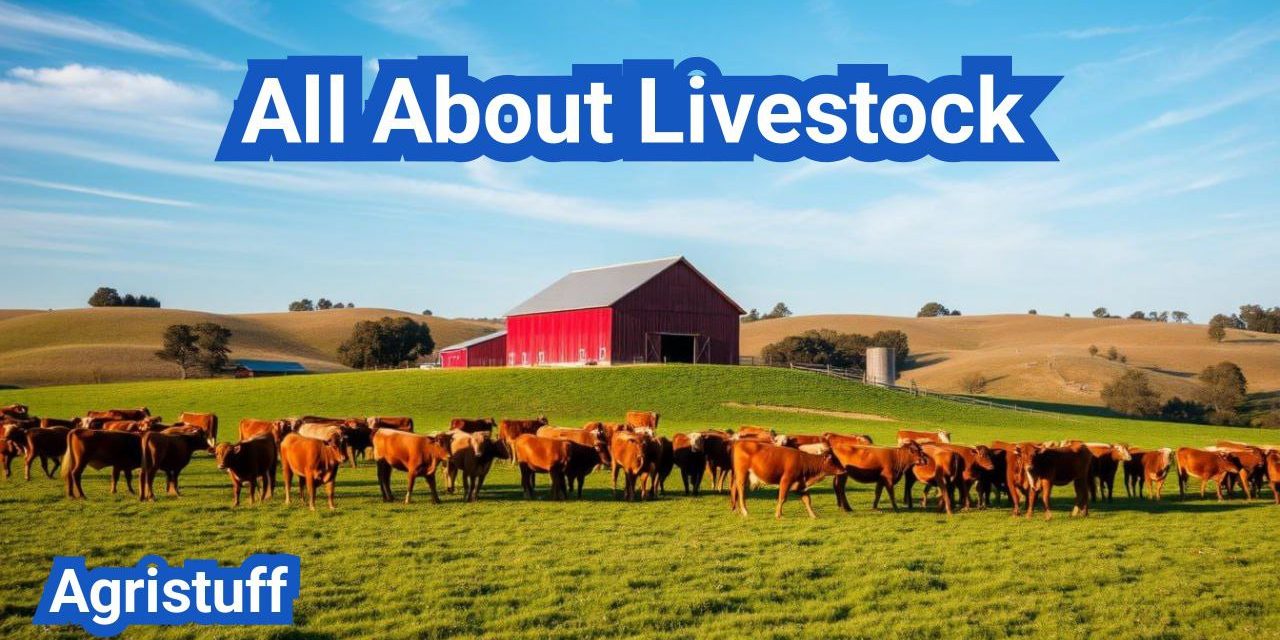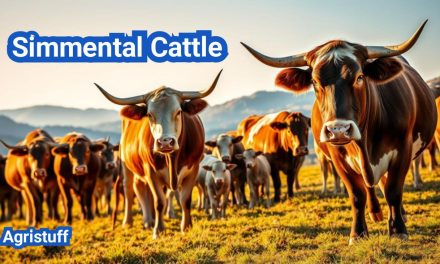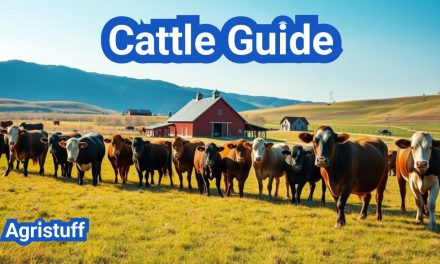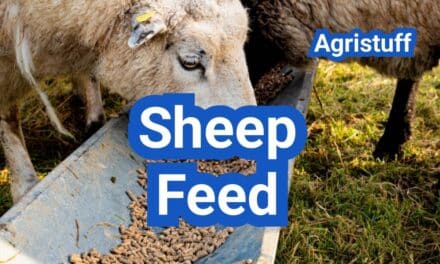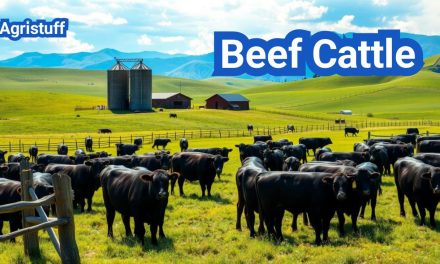Livestock refers to domesticated animals raised in an agricultural setting to provide labor and produce diversified products for consumption.
The term encompasses a wide range of animals, including cattle, sheep, goats, and more, which are often raised for meat, dairy, or labor.
Understanding livestock is crucial for agriculture, as these animals contribute significantly to food production and farm economies.
Key Takeaways
- Definition of livestock and its role in agriculture
- Types of livestock, including cattle and sheep
- Examples of livestock products, such as meat and dairy
- Importance of livestock in farm economies
- Variety of livestock animals raised for different purposes
What Is Livestock? Definition and Meaning
The domestication of livestock marks one of the most significant milestones in human history, transforming the way people live and interact with their environment. Livestock, which includes domesticated animals raised in an agricultural setting to provide labor and produce diversified products for consumption, has been a cornerstone of human society for thousands of years.
Historical Context of Livestock Domestication
The history of livestock domestication dates back to around 10,000 years ago, during the Neolithic period. This era marked a significant shift from nomadic hunting and gathering to settled agriculture. The domestication of animals such as sheep, goats, cattle, and pigs provided a stable source of food, clothing, and labor, revolutionizing human civilization.
The process of domestication involved the selective breeding of wild animals, leading to changes in their behavior, physiology, and anatomy over generations. This selective breeding was driven by human needs, including the desire for reliable sources of meat, milk, wool, and labor.
Key milestones in livestock domestication include:
- The domestication of dogs (Canis lupus familiaris) around 15,000-30,000 years ago, primarily for companionship and hunting assistance.
- The domestication of sheep (Ovis aries), goats (Capra aegagrus hircus), and cattle (Bos taurus) in the Fertile Crescent around 10,000 years ago.
- The domestication of pigs (Sus scrofa) in Asia around 10,000 years ago.
Modern Definition and Classification of Livestock
In modern times, the term “livestock” encompasses a broad range of domesticated animals raised for various purposes. The definition has evolved to include not just traditional farm animals but also other species that are managed for food, fiber, and other products.
Livestock can be classified into several categories based on their use, including:
- Beef cattle and dairy cattle: Raised for meat and milk production.
- Pigs and poultry: Raised for meat and eggs.
- Sheep and goats: Raised for meat, milk, wool, and mohair.
- Horses and other equines: Used for labor, transportation, and companionship.
The classification of livestock is also influenced by factors such as breed, age, and production system. Understanding these classifications is essential for effective animal husbandry and agricultural practices.
In conclusion, livestock plays a vital role in agriculture and human society. By understanding the historical context of livestock domestication and the modern definition and classification of livestock, we can better appreciate the complexities of animal husbandry and its significance in our daily lives.
The Importance of Livestock in Agriculture
Livestock is fundamental to agricultural practices, offering a range of products and services that support local and global economies. The value of global livestock production was estimated at $883 billion in 2013, highlighting its significant economic impact.
Economic Significance and Market Value
The economic significance of livestock is substantial, as it provides a variety of products, including meat, dairy, and wool, which are sold in domestic and international markets. This not only generates income for farmers and related businesses but also contributes to the overall GDP of countries with significant livestock industries.
Market trends and consumer demand play a crucial role in shaping the livestock industry. For instance, the increasing demand for protein-rich foods in emerging markets has led to an expansion in livestock production in regions such as Asia and Latin America.
Food Security and Resource Utilization
Livestock contributes to food security by providing a range of nutritious food products. Meat, milk, and eggs are rich in proteins, vitamins, and minerals essential for human health. Moreover, livestock can utilize resources that are not suitable for crop production, such as grazing on marginal lands or converting by-products into valuable products.
Efficient resource utilization is critical in livestock production. This includes optimizing feed conversion ratios, minimizing waste, and implementing sustainable grazing practices to maintain land productivity and reduce environmental impacts.
By understanding the importance of livestock in agriculture, we can better appreciate the need for sustainable practices and policies that support this vital sector.
How to Get Started with Livestock Farming

Before diving into livestock farming, it’s essential to assess your resources, define your goals, and understand the legal requirements.
Assessing Your Resources and Goals
Starting a livestock farm requires a thorough evaluation of your available resources, including land, capital, and labor. Consider the size of your land and its suitability for different types of livestock. Financial resources are also crucial, as they will determine the scale of your operation and the investments you can make in infrastructure and animal purchases.
Defining your goals is equally important. Are you aiming to produce meat, dairy, or fiber products? Your goals will influence the type of livestock you choose and the management practices you adopt. For instance, if your goal is to produce high-quality beef, you’ll need to select breeds known for their meat production and implement appropriate feeding and handling practices.
Selecting the Right Livestock Species for Your Farm
The choice of livestock species depends on several factors, including climate, market demand, and your farming experience. Different species have different requirements and offer various products. For example, cattle are commonly raised for beef and dairy, while sheep and goats are often kept for meat, milk, or fiber.
| Livestock Species | Primary Products | Climate Suitability |
|---|---|---|
| Cattle | Beef, Dairy | Temperate, Tropical |
| Sheep | Meat, Wool | Temperate, Cold |
| Goats | Meat, Milk, Fiber | Temperate, Arid |
Legal Requirements and Permits
Livestock farming is subject to various legal requirements and regulations, which can vary significantly by location. It’s crucial to familiarize yourself with local, state, and federal laws regarding animal welfare, environmental protection, and business operations.
Some of the legal considerations include obtaining necessary permits, complying with zoning regulations, and adhering to health and safety standards. For example, you may need a permit to construct or modify farm buildings, and you must ensure that your operations comply with environmental regulations to avoid fines or penalties.
By carefully assessing your resources and goals, selecting the appropriate livestock species, and understanding the legal requirements, you can establish a successful and sustainable livestock farming operation.
Cattle: The Cornerstone of Livestock Farming
The cattle industry is a multifaceted sector that encompasses a wide range of breeds and farming practices. Cattle are a fundamental component of livestock farming, providing essential products such as meat, milk, and hides.
Understanding Cattle Terminology
Cattle terminology varies depending on the context, including the animal’s age, sex, and purpose. For instance, a young cattle is often referred to as a calf, while adult females are called cows, and males are known as bulls. Understanding these terms is crucial for effective communication in cattle farming.
Some key cattle terms include:
- Calf: A young cattle, typically in its first year.
- Cow: An adult female cattle that has had at least one calf.
- Bull: An adult male cattle used for breeding.
- Heifer: A young female cattle that has not yet had a calf.
- Steer: A male cattle that has been castrated and is typically raised for beef.
Difference Between Beef and Dairy Operations
Cattle farming can be broadly categorized into beef and dairy operations, each with distinct goals and practices. Beef operations focus on raising cattle for meat production, while dairy operations prioritize milk production.
| Characteristics | Beef Operations | Dairy Operations |
|---|---|---|
| Primary Product | Meat | Milk |
| Breeds | Angus, Hereford, Shorthorn | Holstein-Friesian, Brown Swiss, Ayrshire |
| Feeding Practices | Often involves grazing and finishing on feedlots | Typically involves a diet optimized for milk production |
Basic Cattle Handling Techniques
Effective cattle handling is crucial for the safety of both the animals and the handlers. Basic techniques include moving cattle calmly and quietly, avoiding sudden movements, and using appropriate handling facilities.
Some key handling techniques include:
- Approaching cattle calmly to avoid stressing them.
- Using handling equipment such as chutes and gates to guide cattle.
- Moving cattle in small groups to prevent overcrowding.
By understanding cattle terminology, recognizing the differences between beef and dairy operations, and applying basic handling techniques, farmers can improve the efficiency and safety of their cattle farming practices.
Popular Beef Cattle Breeds

The selection of beef cattle breeds is crucial for the success of a farming operation, influencing factors like meat quality and production efficiency. With a wide range of breeds available, farmers can choose those that best suit their specific needs and environments.
British Breeds
British breeds have been foundational in beef cattle farming, known for their hardiness and quality meat production. Some of the most popular include:
- Angus: Renowned for its high-quality beef, Angus cattle are a favorite among farmers and consumers alike.
- Hereford: Known for their hardiness and fast growth rate, Herefords are widely used in crossbreeding programs.
- Shorthorn: Shorthorns are versatile, used for both beef and dairy production, and are appreciated for their milking ability and fertility.
Continental and Tropical Breeds
In addition to British breeds, Continental and Tropical breeds play significant roles in global beef production.
Continental Breeds like Charolais and Simmental are prized for their rapid growth rates and muscular development, making them ideal for large-scale beef operations.
- Charolais: Originating from France, Charolais cattle are known for their lean meat and are often used in crossbreeding to improve growth rates.
- Simmental: Simmentals are versatile, used in both dairy and beef production, and are recognized for their fast growth and high-quality meat.
Tropical Breeds, such as Brahman and their crosses, are valued for their heat tolerance and resistance to pests and diseases, making them well-suited to challenging environments.
- Brahman: Known for their heat tolerance and resistance to insects, Brahman cattle are often used in hot climates.
Dairy Cattle Breeds and Management
High-production dairy breeds have revolutionized the dairy industry, offering improved milk yields and quality. The success of a dairy operation largely depends on the selection of the right dairy cattle breed and effective management practices.
High-Production Dairy Breeds
Several dairy cattle breeds are renowned for their high milk production. The Holstein-Friesian is one of the most popular dairy breeds globally, known for its high milk yield. Other notable breeds include the Brown Swiss, Ayrshire, Jersey, and Guernsey. Each of these breeds has its unique characteristics and advantages.
- Holstein-Friesian: Known for the highest milk production among dairy breeds.
- Brown Swiss: Recognized for its longevity and high milk production.
- Ayrshire: Adaptable and known for its robust health and milk production.
- Jersey: Famous for its rich milk with high butterfat content.
- Guernsey: Known for its rich, creamy milk and efficient feed conversion.
Setting Up a Dairy Operation
Setting up a dairy operation requires careful planning and management. Key factors include cattle nutrition, health management, and milking practices. A well-managed dairy operation ensures high milk quality and quantity, contributing to the overall success of the farm.
Cattle Nutrition: Providing a balanced diet is crucial for maintaining high milk production. This includes a mix of forages, concentrates, and minerals.
Health Management: Regular veterinary check-ups and a robust health program are essential to prevent diseases and maintain herd health.
Milking Practices: Proper milking techniques and hygiene are vital for producing high-quality milk. This includes regular milking schedules and maintaining clean milking equipment.
How to Start and Manage a Goat Farm

For those looking to start a goat farm, understanding the basics of goat housing, care, and management is crucial. Goat farming can be a rewarding venture, providing products such as milk, meat, and fiber, but it demands a comprehensive approach to farm management.
Setting Up Goat Housing and Facilities
The first step in establishing a goat farm is setting up appropriate housing and facilities. Goats require shelter from extreme weather conditions, such as direct sunlight, heavy rain, and cold temperatures. The housing should be well-ventilated to prevent respiratory issues.
Key Considerations for Goat Housing:
- Space: Ensure enough space for the goats to move around comfortably.
- Fencing: Fencing should be sturdy to prevent escape and predator entry.
- Bedding: Use dry bedding material like straw to keep the area clean and dry.
Daily Goat Care Routine
A daily care routine is vital for maintaining the health and productivity of goats. This includes providing fresh water, nutritious feed, and regular health checks.
Nutritional Needs: Goats are ruminants and require a diet rich in fiber. High-quality hay, supplemented with grains as necessary, can meet their nutritional needs.
| Care Activity | Frequency | Notes |
|---|---|---|
| Feeding | Twice daily | Provide high-quality hay and grains as needed. |
| Health Checks | Daily | Monitor for signs of illness or injury. |
| Hoof Trimming | Every 6-8 weeks | Prevent hoof overgrowth. |
Common Challenges in Goat Farming
Goat farmers often face challenges such as disease management, predator control, and nutritional issues. Being aware of these challenges and having strategies in place can help mitigate their impact.
Disease Prevention: Implementing a vaccination program and maintaining a clean living environment can help prevent diseases.
By understanding the needs of goats and the challenges associated with goat farming, farmers can better manage their farms and improve productivity.
Popular Goat Breeds for Different Purposes

The world of goat farming encompasses a wide range of breeds, each with unique characteristics tailored to specific agricultural needs. Goat breeds are selected based on their suitability for producing milk, meat, or fiber, catering to various market demands.
Dairy Goat Breeds and Their Management
Dairy goat breeds are renowned for their milk production capabilities. Breeds like Saanen and Alpine are popular among dairy farmers due to their high milk yield and quality.
- Saanen: Known for their calm temperament and high milk production, Saanen goats are a favorite among dairy farmers.
- Alpine: Alpine goats are versatile and adaptable, producing rich milk that is ideal for cheese production.
Managing dairy goat breeds requires a focus on nutrition, milking practices, and health care to maintain high milk production levels.
Meat and Fiber Goat Breeds
Meat goat breeds, such as the Boer, are bred for their muscular build and rapid growth rate, making them ideal for meat production.
- Boer: Originating from South Africa, Boer goats are prized for their fast growth rate and high-quality meat.
Fiber goat breeds, like the Angora, are valued for their mohair production. Angora goats require specific care to maintain the quality of their fleece.
- Angora: Known for their soft, luxurious mohair, Angora goats are a significant part of the fiber industry.
Effective management of meat and fiber goat breeds involves careful breeding practices, nutrition planning, and health management to ensure the quality of the final product.
Sheep Farming Fundamentals

Sheep farming involves the rearing of sheep for their wool, meat, and milk, requiring careful management. The success of a sheep farming operation depends on several factors, including the selection of appropriate breeds, provision of suitable housing, and implementation of effective health care practices.
Setting Up a Sheep Operation
Setting up a sheep operation requires meticulous planning. The first step is to assess your resources, including land, finances, and labor. It’s essential to choose a breed that is well-suited to your climate and production goals.
- Selecting the right breed for your operation
- Providing appropriate housing and fencing
- Developing a nutrition plan
- Implementing a health care program
According to the USDA, sheep producers should prioritize animal welfare and environmental sustainability. “Sheep producers are increasingly focusing on sustainable practices that promote the health and well-being of their animals, as well as the environment,” says a report by the USDA.
“The key to successful sheep farming lies in the ability to balance economic viability with animal welfare and environmental stewardship.”
– Dr. Jane Smith, Sheep Farming Expert
Basic Sheep Care Calendar
A basic sheep care calendar is crucial for maintaining the health and productivity of your flock. This includes regular vaccinations, parasite control measures, and hoof trimming.
| Month | Care Activity |
|---|---|
| January | Vaccinations and parasite control |
| March | Hoof trimming |
| June | Shearing |
| September | Reproductive management |
Effective sheep farming also involves continuous monitoring of the flock’s health and adjusting management practices as needed. By following a structured care calendar and staying informed about best practices, sheep farmers can optimize their operations.
Notable Sheep Breeds and Their Characteristics

Sheep are one of the most diverse livestock species, with breeds catering to wool, meat, and milk production. This diversity allows farmers and producers to select breeds that best suit their operational goals and environmental conditions.
Wool Production Breeds
Wool production is a significant aspect of sheep farming, with certain breeds being renowned for their high-quality wool. The Merino sheep is one of the most celebrated wool-producing breeds globally.
The Merino breed is prized for its fine wool, which is soft, resilient, and highly valued for textile production. Merino sheep are known for their adaptability to various climates, making them a popular choice for farmers in different parts of the world.
Meat Production Breeds
For meat production, several sheep breeds stand out for their growth rates, muscle mass, and meat quality. Breeds like Suffolk and Dorper are prominent in the meat sheep industry.
The Suffolk breed is known for its rapid growth rate and muscular build, making it a favorite among meat producers. Dorper sheep, on the other hand, are appreciated for their hardiness and ability to thrive in challenging environments.
Here’s a comparison of some notable sheep breeds for wool and meat production:
| Breed | Primary Use | Characteristics |
|---|---|---|
| Merino | Wool | Fine wool, adaptable, hardy |
| Suffolk | Meat | Rapid growth, muscular |
| Dorper | Meat | Hardy, adaptable, low maintenance |
Effective Livestock Management Practices

To ensure the longevity and productivity of livestock, farmers must adopt comprehensive management practices. Effective livestock management is crucial for maintaining the health, welfare, and productivity of animals on the farm.
Developing a Herd Health Program
A well-structured herd health program is essential for preventing disease and promoting overall animal health. This involves regular veterinary check-ups, vaccinations, and parasite control measures. Vaccination programs should be tailored to the specific needs of the herd, taking into account factors such as age, health status, and disease prevalence in the area.
“A healthy herd is the backbone of any successful livestock operation,” emphasizes the importance of proactive health management. Implementing a robust health program not only improves animal welfare but also enhances farm productivity and profitability.
Record Keeping Systems for Livestock
Accurate and comprehensive record keeping is vital for effective livestock management. Records should include information on animal health, breeding, feeding, and growth rates. Digital record keeping systems can streamline data collection and analysis, enabling farmers to make informed decisions.
- Health records: Documenting vaccinations, treatments, and disease incidents.
- Breeding records: Tracking reproductive cycles, breeding dates, and birth outcomes.
- Production records: Monitoring milk production, growth rates, and feed conversion ratios.
Handling Facilities and Equipment
Proper handling facilities and equipment are critical for safe and efficient livestock management. Well-designed handling systems reduce stress on animals and improve worker safety. Handling facilities should be designed to minimize animal stress and prevent injury.
“The design of handling facilities can significantly impact the ease and safety of livestock handling,” notes a leading agricultural expert. “Investing in quality handling equipment pays dividends in terms of reduced stress and improved productivity.”
Key considerations for handling facilities include:
| Facility Component | Design Consideration | Benefit |
|---|---|---|
| Chutes and Alleys | Non-slip flooring, adequate width | Reduces animal stress and injury |
| Crowding Pens | Proper sizing for the number of animals | Facilitates efficient handling |
| Squeeze Chutes | Adjustable to accommodate different sizes | Enhances safety for both animals and handlers |
Livestock Nutrition and Feeding Guidelines

Proper nutrition is essential for livestock, influencing their growth, reproduction, and overall well-being. A well-balanced diet is crucial for maintaining healthy animals and optimizing farm productivity.
Understanding Basic Nutritional Requirements
Livestock require a diet that includes a mix of nutrients such as proteins, carbohydrates, vitamins, and minerals. The specific nutritional needs can vary depending on the species, age, and production level of the animals.
Nutritional Components:
- Proteins: Essential for growth and repair
- Carbohydrates: Primary energy source
- Vitamins and Minerals: Crucial for various bodily functions
Forage-Based Feeding Systems
Forage-based feeding systems are common in livestock farming, utilizing grasses, hay, and other plant materials as the primary feed source. These systems can be cost-effective and help maintain the health of the animals.
The quality and quantity of forage can significantly impact the nutritional intake of livestock. Farmers must ensure that the forage is of high quality and that it meets the nutritional needs of their animals.
Supplemental Feeding Strategies
Supplemental feeding involves providing additional nutrients to livestock beyond what they receive from forage. This can be necessary to meet specific nutritional requirements, especially during periods of high production or stress.
| Supplement Type | Purpose | Examples |
|---|---|---|
| Energy Supplements | Increase energy intake | Grain, Corn |
| Protein Supplements | Enhance protein intake | Soybean Meal, Cottonseed Meal |
| Mineral Supplements | Provide essential minerals | Calcium, Phosphorus |
By understanding and implementing appropriate feeding strategies, farmers can improve the health and productivity of their livestock, ultimately contributing to a more sustainable and profitable farming operation.
Livestock Breeding and Reproduction Management

Optimizing livestock breeding and reproduction management is essential for achieving desired outcomes in livestock production. Effective breeding programs can significantly enhance the quality and quantity of livestock, directly impacting farm productivity and profitability.
Breeding Methods and Selection Criteria
Livestock breeding involves various methods, including selective breeding, crossbreeding, and purebred breeding. The choice of breeding method depends on the farm’s goals, such as improving milk production, enhancing meat quality, or increasing disease resistance. Selection criteria are critical in breeding programs, focusing on traits like fertility, growth rate, and genetic diversity.
For instance, in dairy farming, selection criteria often prioritize milk yield and quality. In contrast, beef cattle breeding may focus on growth rate, meat quality, and muscling. Genetic testing and performance recording are tools used to make informed breeding decisions.
Reproductive Timing and Seasonal Considerations
Reproductive timing is crucial in livestock breeding, as it affects the overall productivity and efficiency of the breeding program. Farmers must consider the reproductive cycles of their animals, including the estrous cycle in cattle and the breeding season for sheep and goats.
Seasonal considerations also play a significant role, as certain times of the year may be more conducive to breeding due to factors like climate and feed availability. For example, some farms may synchronize breeding to ensure that births occur during favorable weather conditions.
Assisted Reproduction Technologies
Assisted reproduction technologies (ART) have revolutionized livestock breeding by improving reproductive efficiency and genetic gain. Techniques such as artificial insemination (AI) and embryo transfer are widely used in modern livestock production.
AI allows for the dissemination of superior genetics across a wider population, while embryo transfer enables the production of multiple offspring from high-quality females. These technologies have significantly contributed to the advancement of livestock breeding programs worldwide.
Animal Welfare in Livestock Production
Animal welfare is a critical consideration for ethical livestock production. Ensuring the well-being of animals is not only a moral obligation but also crucial for the sustainability and efficiency of livestock farming.
Implementing the Five Freedoms on Your Farm
The Five Freedoms provide a comprehensive framework for assessing and enhancing animal welfare. These freedoms are:
- Freedom from hunger and thirst
- Freedom from discomfort
- Freedom from pain, injury, or disease
- Freedom to express normal behavior
- Freedom from fear and distress
Implementing these freedoms requires careful planning and management. For instance, providing adequate nutrition and ensuring access to clean water addresses the first freedom. Creating comfortable living conditions, including appropriate shelter and resting areas, fulfills the second freedom.
| Freedom | Practical Implementation |
|---|---|
| Freedom from hunger and thirst | Provide adequate nutrition and clean water |
| Freedom from discomfort | Ensure comfortable living conditions |
| Freedom from pain, injury, or disease | Implement effective health management practices |
| Freedom to express normal behavior | Provide sufficient space and appropriate environment |
| Freedom from fear and distress | Handle animals gently and avoid stressful conditions |
Humane Handling and Transportation Practices
Humane handling and transportation are crucial aspects of animal welfare in livestock production. Handling animals with care reduces stress and prevents injuries. Practices include moving animals calmly and avoiding the use of sticks or other objects that might cause harm.
Transportation practices also play a significant role in animal welfare. Ensuring that vehicles are suitable for transporting livestock, maintaining clean and comfortable conditions, and minimizing travel times are essential. Regular inspections of vehicles and equipment are necessary to prevent any potential harm.
By focusing on animal welfare through the implementation of the Five Freedoms and humane handling and transportation practices, livestock producers can improve the lives of their animals while also enhancing the sustainability and reputation of their operations.
Sustainable Livestock Farming Practices
As the world grapples with environmental challenges, sustainable livestock farming emerges as a vital strategy for a greener future. This approach not only helps in reducing the ecological footprint of farming activities but also enhances the overall productivity and sustainability of the farm.
Rotational Grazing Systems
Rotational grazing is a cornerstone of sustainable livestock farming. By rotating livestock through different grazing areas, farmers can prevent overgrazing, promote soil health, and increase biodiversity. This practice also helps in maintaining the quality of the pasture, reducing erosion, and improving water infiltration.
Benefits of Rotational Grazing:
- Improved soil health and fertility
- Increased pasture productivity and quality
- Enhanced biodiversity and ecosystem services
- Reduced soil erosion and water pollution
Manure Management and Utilization
Effective manure management is crucial for minimizing the environmental impact of livestock farming. Manure can be a valuable resource when managed properly, providing nutrients for crops and improving soil structure. Strategies for manure management include storage, treatment, and application techniques that minimize nutrient loss and environmental contamination.
“Proper manure management is not just about reducing environmental impact; it’s also about maximizing the nutrient value of manure for crop production.”
Reducing Environmental Impact
Livestock farming can have significant environmental impacts, including greenhouse gas emissions, water pollution, and habitat destruction. However, by adopting sustainable practices, farmers can mitigate these effects. Strategies include implementing conservation tillage, restoring habitats, and using renewable energy sources.
Strategies for Reducing Environmental Impact:
- Implementing energy-efficient practices and renewable energy sources
- Conserving water and reducing water pollution
- Restoring and preserving natural habitats
- Reducing, reusing, and recycling farm waste
In conclusion, sustainable livestock farming practices are essential for promoting environmental stewardship while maintaining agricultural productivity. By adopting rotational grazing, effective manure management, and strategies to reduce environmental impact, farmers can contribute to a more sustainable food system.
The Future of Livestock Farming
The future of livestock farming is poised to involve significant advancements in sustainable agriculture practices, prioritizing animal welfare, and leveraging technology to enhance livestock production. As global demand for meat, dairy, and other animal products continues to rise, farmers and producers must adopt efficient and humane methods.
Sustainable livestock farming practices, such as rotational grazing and effective manure management, will reduce the environmental impact of livestock production. Improving animal welfare standards benefits both animals and the industry, contributing to a more sustainable and productive livestock sector.
By embracing innovative technologies and best practices, the livestock farming sector can ensure a more sustainable future. Implementing the Five Freedoms on farms, improving handling and transportation practices, and utilizing assisted reproduction technologies will enhance breeding programs.
Integrating sustainable agriculture practices, animal welfare, and advanced livestock production techniques will shape the future of the industry.
FAQ
What is livestock?
Livestock refers to domesticated animals raised on farms or ranches for food, fiber, or other products. Examples include cattle, goats, sheep, and poultry.
Why is livestock important in agriculture?
Livestock is crucial in agriculture as it provides food, income, and employment for many people. It also contributes to soil fertility through manure and helps maintain ecosystem balance.
What are the different types of livestock?
Common types of livestock include cattle (beef and dairy), goats (dairy, meat, and fiber), sheep (wool and meat), and poultry. Each type has various breeds suited for different purposes.
How do I start a livestock farm?
To start a livestock farm, assess your resources and goals, choose the right livestock species, and comply with local regulations and obtain necessary permits.
What are the key considerations for cattle farming?
Key considerations for cattle farming include understanding cattle terminology, differentiating between beef and dairy operations, and mastering basic cattle handling techniques.
What are some popular beef cattle breeds?
Popular beef cattle breeds include British breeds like Angus and Hereford, Continental breeds, and Tropical breeds like Brahman. Each has unique characteristics and uses.
How do I manage a dairy cattle operation?
Managing a dairy cattle operation involves selecting high-production dairy breeds, setting up a dairy operation, and ensuring proper nutrition and health care for the cattle.
What are the benefits of goat farming?
Goat farming offers benefits like versatility (dairy, meat, and fiber production), relatively low initial investment, and the ability to thrive on marginal lands.
How do I care for sheep?
Caring for sheep involves setting up a suitable sheep operation, providing a basic sheep care calendar, and ensuring proper nutrition, health care, and handling.
What are some effective livestock management practices?
Effective livestock management practices include developing a herd health program, maintaining accurate records, and using appropriate handling facilities and equipment.
What are the nutritional requirements for livestock?
Livestock nutritional requirements vary by species and production purpose but generally include adequate energy, protein, vitamins, and minerals. Forage-based feeding systems are common, supplemented as necessary.
How can I improve livestock breeding and reproduction?
Improving livestock breeding and reproduction involves selecting appropriate breeding methods, understanding reproductive timing, and potentially using assisted reproduction technologies.
Why is animal welfare important in livestock production?
Animal welfare is crucial as it ensures the humane treatment of livestock, improves productivity, and enhances the sustainability of livestock farming. Implementing the Five Freedoms is a key aspect.
What are sustainable livestock farming practices?
Sustainable livestock farming practices include rotational grazing, effective manure management, and strategies to reduce environmental impact, such as minimizing waste and conserving resources.
How can I reduce the environmental impact of my livestock farm?
Reducing environmental impact involves practices like rotational grazing, proper manure management, and minimizing the use of external inputs like fertilizers and pesticides.
Conclusion of: Livestock
Livestock are domesticated animals raised in agricultural settings to produce commodities such as food, fiber, and labor. They play a crucial role in human society, providing essential resources for our daily lives. Understanding livestock, their types, management practices, and their impact on the environment and economy is essential for efficient agricultural practices.
What is Livestock?
Livestock refers to farm animals kept and raised to serve various purposes, including meat, milk, wool, and labor. Common livestock animals include cattle, sheep, goats, pigs, horses, poultry, and rabbits. The term “livestock” covers a broad category of animals, each having unique management needs and uses. USDA Livestock Definition
Types of Livestock
Different types of livestock are categorized based on their purposes and characteristics. Each type has specific management and care requirements.
- Cattle: Primarily raised for meat (beef cattle) and milk (dairy cattle). Common breeds include Angus and Holstein. Cattle Information
- Sheep: Raised for wool, meat, and milk. Breeds like Merino and Suffolk are famous for wool and meat production respectively. Sheep Production Guide
- Goats: Kept for meat, dairy, and fiber production. Popular breeds include Boer for meat and Saanen for milk production. Goat Management
- Pigs: Valued mainly for pork. Breeds such as Yorkshire and Duroc are renowned for efficient meat production. Pig Farming
- Poultry: Chickens, ducks, and turkeys raised mainly for eggs and meat. Broiler chickens and layer hens are common types. Poultry Information
- Horses: Traditionally used for transportation, farm work, sports, and companionship. Breeds vary significantly in size and purpose. Equine Industry
- Rabbits: Often raised for meat and fur, rabbits are increasingly popular as pets due to their ease of handling and minimal space requirements. Rabbit Farming
Importance of Livestock
Livestock significantly contributes to human nutrition by providing protein-rich foods such as meat, milk, and eggs. They are also vital for rural economies, generating income through sales and employment opportunities in agricultural sectors.
Moreover, livestock can improve agricultural productivity through draft power, manure for fertilizer, and maintaining ecosystem balance by grazing. Livestock Economic Importance
Livestock Management Practices
Proper livestock management is essential for animal welfare, productivity, and profitability. It includes feeding, breeding, housing, and health management.
- Feeding: Providing balanced diets tailored to the specific nutritional requirements of each livestock type ensures good health and optimal production levels. Livestock Nutrition
- Breeding: Selective breeding practices help enhance desirable traits such as growth rate, meat quality, milk production, and disease resistance. Animal Breeding
- Housing: Appropriate housing protects livestock from extreme weather conditions, predators, and diseases, contributing significantly to their overall welfare and productivity. Livestock Housing Guide
- Health Management: Regular vaccinations, parasite control, and veterinary check-ups are critical to preventing diseases and maintaining high productivity levels. Animal Health
Environmental Impact of Livestock
Livestock farming impacts the environment in multiple ways, both positively and negatively. While manure enhances soil fertility, improper manure management can cause water contamination. Methane emissions from ruminants like cattle contribute significantly to greenhouse gas emissions. However, sustainable practices such as rotational grazing and improved feed efficiency can mitigate negative impacts. Livestock and Environment
Economic Impact of Livestock
Livestock production is a cornerstone of many economies, especially in rural areas. It provides livelihoods for millions globally through direct farming, processing, transportation, and retail sectors. The economic activities associated with livestock are significant drivers of local and global markets. Livestock Economy
Final Thought
Understanding livestock’s role in agriculture, types, management practices, and environmental and economic impacts is crucial for sustainable agricultural development. Proper management strategies and sustainable practices can significantly enhance productivity while reducing environmental footprints.

